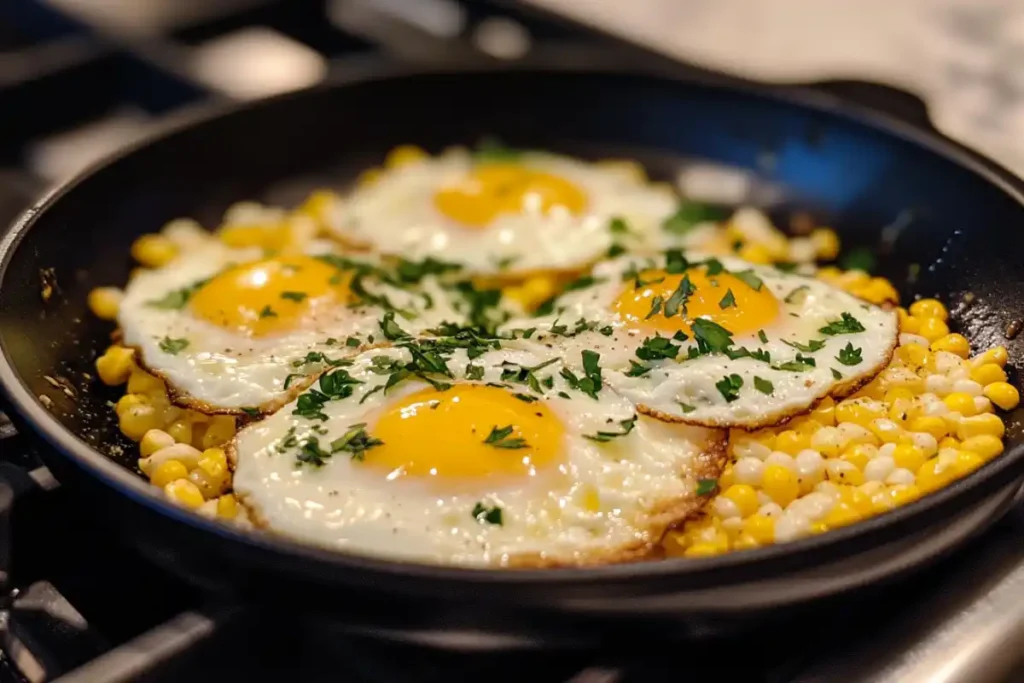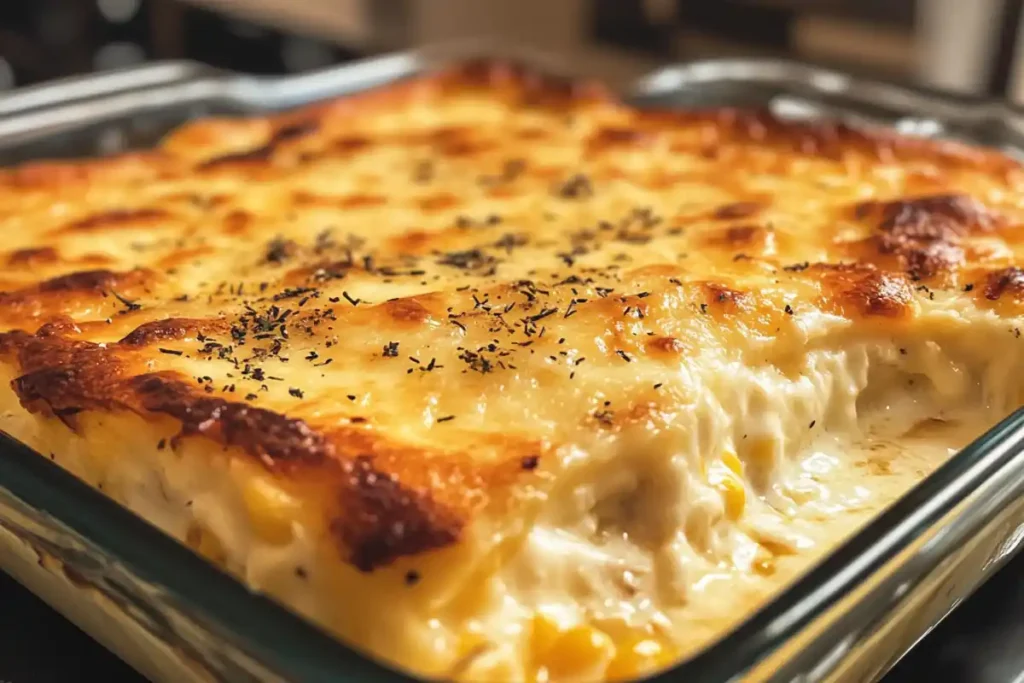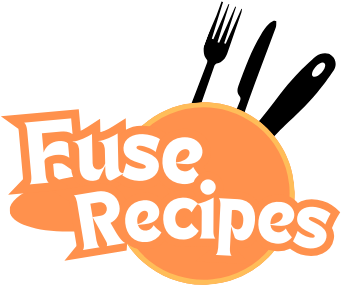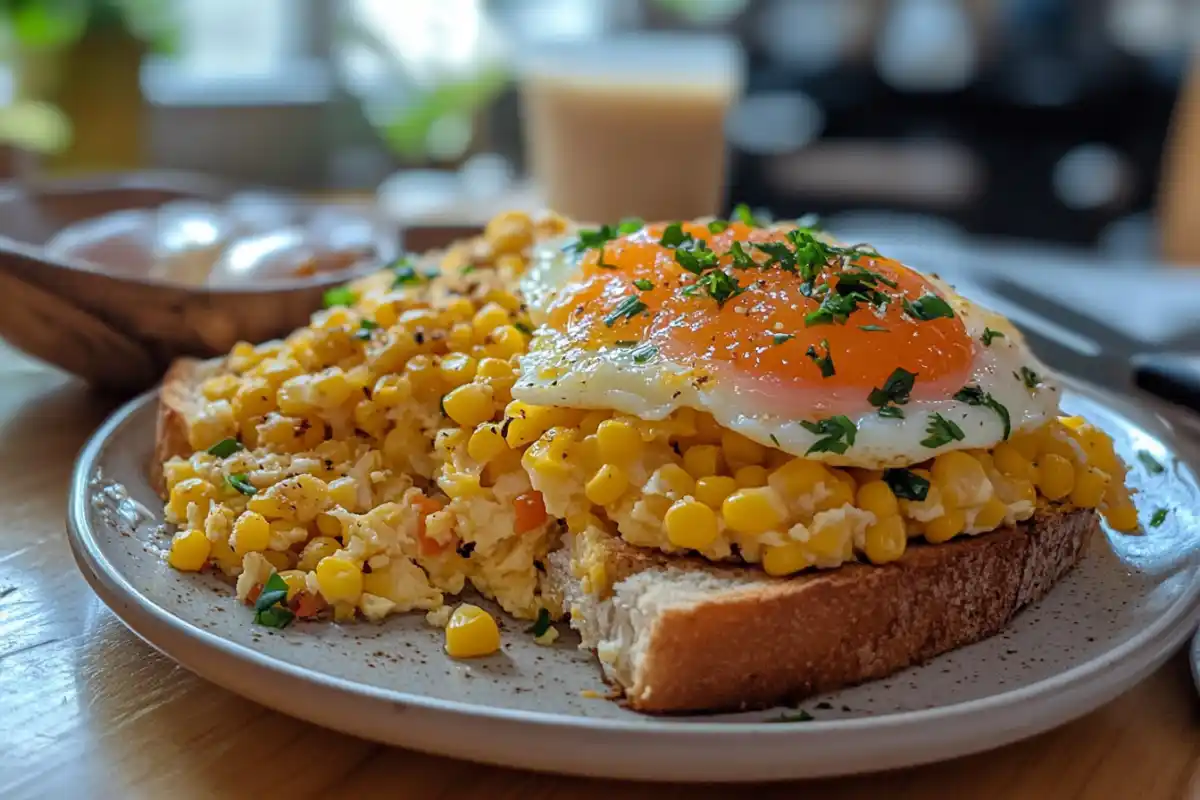Discover the delicious world of Schmaltz dish, eggs, cheese, and corn in this mouthwatering recipe that brings together rich flavors and creamy textures.
Schmaltz egg cheese corn is a delightful culinary blend that combines the luscious richness of schmaltz with the creamy goodness of cheese, the light fluffiness of eggs, and the sweet crunch of corn. This article will explore every aspect of this delightful dish, offering an in-depth recipe, pairing ideas, and everything you need to know to prepare a perfect schmaltz egg cheese corn at home.

Introduction to Schmaltz dish, Egg, Cheese, and Corn as a Unique Culinary Combination
Schmaltz, egg, cheese, and corn may not be the first combination that comes to mind for most cooks. However, this dynamic mix of ingredients provides a unique and balanced culinary experience. The smooth, rich flavor of schmaltz—a type of rendered chicken or goose fat—pairs beautifully with the creaminess of cheese and the fluffy, light texture of eggs. Adding corn offers a burst of sweetness and a slight crunch, resulting in a well-rounded dish that is both indulgent and satisfying.
The beauty of this recipe lies in how each ingredient interacts, creating a dish that is greater than the sum of its parts. In the upcoming sections, we’ll break down each of the components, their role in the dish, and how you can create a perfect version of this delightful comfort food.
What is Schmaltz?
History of Schmaltz in Culinary Traditions
Schmaltz is an essential element in many traditional dishes, particularly within Jewish cuisine. It dates back centuries and has been used primarily for cooking and adding flavor to various foods. Historically, schmaltz was born out of necessity. In cultures where kosher diets were followed strictly, pork fat was off-limits, making schmaltz an ideal substitute. Today, schmaltz is enjoying a resurgence, thanks to its rich, velvety texture and deep flavor profile that elevate any dish it graces.
This ingredient is now being reintroduced into modern cooking, becoming a popular element among chefs seeking to bring more depth to their dishes. Its unique taste, along with its versatility, has made it a beloved choice in both traditional and contemporary kitchens.
What Does Schmaltz Bring to the Table?
The allure of schmaltz lies in its unmatched richness and savory quality. When compared to butter or other cooking fats, schmaltz offers a flavor that is robust and nuanced. It brings a certain nostalgia, and the taste can evoke memories of comforting home-cooked meals.
Schmaltz not only contributes a luxurious fat content that enhances the mouthfeel but also acts as an excellent carrier of flavor, making it the perfect base for this egg cheese corn dish. It gives the ingredients a distinct depth of taste that other fats cannot replicate, making the dish uniquely satisfying.
Homemade Schmaltz dish vs. Store-Bought
If you are new to schmaltz, you might be wondering whether to make it at home or buy it pre-made. Homemade schmaltz is not difficult to prepare, and it brings an authentic flavor that many find superior. On the other hand, store-bought versions are convenient and can work well when you’re short on time.
Making Schmaltz at Home:
- Start with chicken skin and fat (available from your butcher).
- Cook the chicken skin slowly over medium heat until the fat is rendered, and the pieces become crispy.
- Strain and reserve the fat—now you have a fresh batch of homemade schmaltz!
For those who prefer convenience, high-quality schmaltz can often be found in specialty grocery stores or ordered online. Not only does schmaltz make a difference in this dish, but it can also be used in numerous other recipes that call for a rich, savory fat.
Ingredients of Schmaltz dish
The Importance of Eggs in the Recipe
Eggs are fundamental in this schmaltz, cheese, and corn dish, acting as both a binder and a source of fluffiness. Eggs provide texture, cohesion, and a subtle flavor that blends harmoniously with the schmaltz and cheese. It’s important to use fresh eggs, preferably free-range, as their superior quality will enhance the final product’s taste and texture.
The way the eggs are cooked also matters. Cooking them to just the right consistency—creamy but set—ensures they hold together with the cheese and corn, creating a comforting, slightly rich dish without being overly dense. Additionally, eggs are a great source of protein, making this recipe both delicious and nutritious.
Choosing the Best Cheese
Selecting the right cheese is key to achieving the desired creaminess and richness in this dish. Here are some options to consider:
- Aged Cheddar: Adds a sharpness that balances the richness of the schmaltz.
- Gruyere: Provides a nutty flavor that pairs well with the sweetness of the corn.
- Mozzarella: If you prefer a milder taste, mozzarella melts smoothly and adds creaminess without overpowering other flavors.
Ultimately, the choice of cheese is flexible. Each type of cheese brings its own distinctive taste, allowing you to tailor the dish according to your preferences. Combining two types of cheese can also be an excellent idea to add complexity—for example, cheddar for sharpness and mozzarella for that creamy texture.
All About Corn: The Sweet and Earthy Touch
Corn plays an essential role in this dish, adding natural sweetness and texture. Fresh corn is preferred whenever possible because of its juicy kernels and fresh flavor. However, canned or frozen corn works well too and is a convenient option if fresh corn is not available.
Corn’s slight sweetness perfectly contrasts with the richness of schmaltz and cheese, making it an indispensable component of this schmaltz, egg, cheese, and corn creation. The sugars in corn caramelize slightly when cooked, enhancing its natural flavor and adding a subtle complexity to the dish. Using grilled or roasted corn can add a smoky element, which further enriches the overall taste profile.
Ingredient Interaction: How Schmaltz, Egg, Cheese, and Corn Complement Each Other

The interplay of these four key ingredients is what makes this dish shine. The rich fattiness of schmaltz combines with the light, fluffy texture of eggs, the creamy depth of cheese, and the subtle sweetness of corn. This combination results in a dish that is indulgent without being overwhelming. The key lies in the balance—each component brings a unique quality, yet none overpowers the others.
Additionally, the combination of these ingredients brings a powerful nutritional profile. Schmaltz provides healthy fats, eggs deliver high-quality protein, cheese adds calcium and more protein, while corn brings essential vitamins and fiber. Altogether, this dish serves as both a comfort food and a balanced meal.
Recipe for Schmaltz Egg Cheese Corn
Ingredients List
To make this rich and satisfying dish, you will need the following ingredients:
- 3 tablespoons schmaltz (rendered chicken fat)
- 4 large eggs
- 1 cup grated cheese (e.g., cheddar, gruyere, or mozzarella)
- 1 cup corn kernels (fresh, frozen, or canned)
- Salt and pepper, to taste
- Optional: 1 tablespoon chopped fresh herbs (e.g., parsley, chives)
- Optional: ¼ teaspoon smoked paprika or chili flakes for added flavor
Step-by-Step Cooking Instructions
Preparation Phase
- Gather Ingredients: Measure out all your ingredients and ensure they are ready to use.
- Prepare Corn: If using fresh corn, remove kernels from the cob. If using frozen corn, thaw it ahead of time.
Cooking Instructions
- Heat Schmaltz: In a large skillet, heat the schmaltz over medium heat until it melts and becomes fragrant.
- Add Corn: Add the corn to the skillet and cook for 3-4 minutes, stirring occasionally until the corn begins to brown slightly.
- Add Eggs: Crack the eggs directly into the skillet, allowing them to mix slightly with the corn.
- Add Cheese: Sprinkle the grated cheese evenly over the eggs and corn.
- Cook: Allow the mixture to cook until the eggs are set, and the cheese is melted—about 5-6 minutes. Stir occasionally to ensure even cooking.
- Season: Season with salt, pepper, and any optional herbs before serving.
Tips for Perfect Consistency
- Cook the eggs over medium heat to prevent them from becoming rubbery.
- Stir gently to retain a nice texture; you want a combination of set eggs and melted cheese throughout.
- If you like a slightly crispy finish, let the bottom layer cook a bit longer before stirring.
Customizations and Variations
Adding Additional Flavors
- Spices: Paprika or smoked chili powder can add an extra kick to this dish.
- Herbs: Fresh herbs such as parsley or chives add color and a fresh burst of flavor.
- Garlic: Add minced garlic to the schmaltz for a savory aroma.
Vegetarian Version
Instead of schmaltz, you can use olive oil or butter to create a vegetarian-friendly version. While this won’t have the exact same depth of flavor, the result will still be delicious and comforting. Coconut oil could also be used to add a slight sweetness that complements the corn.
Dietary Adaptations
- Keto: To make this dish keto-friendly, ensure you use high-fat cheese and add an extra spoon of schmaltz. You may also add a touch of heavy cream to increase the fat content.
- Dairy-Free: Use dairy-free cheese and an extra spoon of schmaltz to maintain creaminess. Nutritional yeast can also be added to mimic the cheesy flavor.
Creating a Creamy Schmaltz Egg Cheese Corn Bake
If you’re looking to take this dish a step further, consider turning it into a baked casserole. This adaptation works particularly well for a family meal or a comforting brunch.
- Prepare the Schmaltz Egg Cheese Corn as described above, but slightly undercook the eggs.
- Transfer to Baking Dish: Pour the mixture into a greased baking dish.
- Add Toppings: Sprinkle extra cheese on top and add a few dollops of schmaltz for added richness.
- Bake: Place in a preheated oven at 375°F (190°C) and bake for 15-20 minutes, or until the top is golden and bubbly.
- Garnish: Garnish with fresh herbs and serve warm.
This baked version is a great option when you’re entertaining or simply want something you can prepare ahead of time and pop in the oven when ready.
Nutritional Breakdown and Health Benefits of Schmaltz dish
Caloric Information and Macronutrient Breakdown
This schmaltz egg cheese corn recipe is both rich and nutritious, making it a well-rounded meal option. Here’s a rough breakdown of its nutritional content:
- Calories: Approximately 450-500 per serving
- Protein: 20-25 grams per serving, thanks to the eggs and cheese
- Fat: 35-40 grams per serving, primarily from schmaltz and cheese, providing essential fatty acids
- Carbohydrates: 10-15 grams per serving, primarily from the corn, which provides fiber and essential vitamins
This dish is high in protein and healthy fats, making it suitable for those following a low-carb or ketogenic diet. It’s also rich in calcium and vitamin D from the cheese and contains essential vitamins and fiber from the corn.
Health Benefits of Schmaltz, Eggs, Cheese, and Corn
Healthy Fats from Schmaltz dish
Contrary to popular belief, not all fats are bad. Schmaltz provides healthy saturated fats that help in the absorption of fat-soluble vitamins (A, D, E, and K). It also contains oleic acid, which is beneficial for heart health.
Protein Power from Eggs and Cheese
Eggs are known as one of nature’s most complete sources of protein. They provide all the essential amino acids required for muscle repair and growth. Cheese also contributes a good amount of protein, making this dish a fantastic option for breakfast or post-workout recovery.
Corn’s Nutrient Content
Corn provides important nutrients, including vitamin C, folate, and magnesium. It also contains antioxidants like lutein and zeaxanthin, which are beneficial for eye health. Its fiber content helps support healthy digestion and makes this dish more satisfying.
Possible Dietary Concerns
While this dish has many health benefits, it’s also important to note some considerations:
- High-Calorie Content: Due to the combination of schmaltz, cheese, and eggs, this dish is calorie-dense. It’s best enjoyed in moderation, especially for those on a calorie-restricted diet.
- High in Saturated Fats: The dish contains a significant amount of saturated fats. While these are essential in moderation, those with cholesterol concerns should consult a dietitian.
Serving Suggestions and Pairing Ideas

Ideal Serving Styles
This dish is versatile and can be served in different ways depending on the occasion. Here are some serving ideas:
- Breakfast or Brunch: Serve alongside toast or fresh sourdough bread for a hearty breakfast.
- Main Course: Pair with a simple green salad for a balanced lunch or dinner.
- Appetizer: Serve in small portions as a warm, comforting appetizer during a family gathering.
Best Side Dishes to Pair With
- Green Salad: A light, crisp salad with a simple vinaigrette helps balance the richness of the schmaltz, eggs, and cheese.
- Roasted Vegetables: Roasted bell peppers, zucchini, or broccoli add extra nutrition and offer contrasting textures.
- Bread: Freshly baked crusty bread or garlic bread makes a great accompaniment, perfect for soaking up any leftover creamy egg mixture.
Beverage Pairing Recommendations
- White Wine: A crisp Sauvignon Blanc pairs well with the rich flavors of this dish, cutting through the creaminess and enhancing the flavors.
- Sparkling Water with Lemon: For a non-alcoholic option, sparkling water with a splash of lemon keeps the palate refreshed.
- Herbal Tea: If serving for breakfast, herbal tea such as chamomile or peppermint complements the dish beautifully.
Presentation Tips
To make this dish visually appealing:
- Garnish: Fresh herbs like parsley or chives provide a pop of color that contrasts nicely with the golden hues of the eggs and cheese.
- Cheese Grating: Add a final sprinkling of grated cheese on top before serving to create a beautiful, melted layer.
- Serve in Cast Iron Skillet: Cooking and serving in a cast iron skillet makes for a rustic presentation that retains heat well, keeping the dish warm longer.
Frequently Asked Questions of Schmaltz dish
What is the Best Cheese to Use for Schmaltz Egg Cheese Corn?
The best cheese depends on your taste preference. Aged cheddar adds a sharp contrast, while mozzarella provides a milder, creamier taste. Gruyere brings a nutty note that pairs well with schmaltz.
Can I Substitute Schmaltz with Another Cooking Fat?
Yes, you can substitute schmaltz with other fats such as butter, olive oil, or even coconut oil. However, schmaltz provides a unique flavor that is hard to replicate with other fats.
Is Schmaltz Egg Cheese Corn Suitable for Vegetarians?
To make this dish vegetarian, replace schmaltz with a vegetarian-friendly fat like olive oil or butter. The rest of the ingredients are vegetarian-friendly.
Can I Make This Recipe Ahead of Time?
Yes, you can prepare this dish ahead of time. Store it in an airtight container in the refrigerator for up to two days. Reheat gently in a skillet or oven before serving.
How Do I Store Leftovers?
Leftovers should be stored in an airtight container in the refrigerator and consumed within 2-3 days. Reheat in a skillet over medium heat for the best texture.
Conclusion
The combination of schmaltz, egg, cheese, and corn creates a unique and comforting dish that is full of flavor. Whether enjoyed for breakfast, brunch, or dinner, this schmaltz egg cheese corn dish is a celebration of rich textures and balanced flavors. Schmaltz adds depth, the eggs bring fluffiness, cheese offers creaminess, and corn adds a delightful crunch and sweetness.

We encourage you to give this recipe a try and experience firsthand how these simple ingredients come together to create something special. Whether you’re a fan of traditional comfort food or looking for a unique new dish to impress your friends and family, this recipe has something for everyone.
Don’t forget to experiment with the variations and make it your own—whether by adding spices, switching up the cheese, or trying different ways of cooking. Happy cooking!
More Delicious Recipes :
nickers Strawberry Cheesecake: A Deliciously Decadent Treat
Healthy Breakfast Curry Recipe

